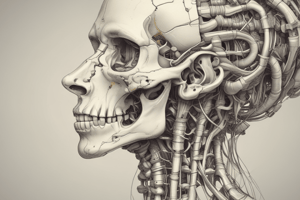Podcast
Questions and Answers
How many vertebrae make up the cervical spine?
How many vertebrae make up the cervical spine?
- 8
- 6
- 7 (correct)
- 5
Which cervical vertebra is ring-shaped and supports the head?
Which cervical vertebra is ring-shaped and supports the head?
- C3
- C1 (correct)
- C2
- C7
What type of joints are the facet joints between vertebrae?
What type of joints are the facet joints between vertebrae?
- Gliding joints (correct)
- Pivot joints
- Hinge joints
- Ball-and-socket joints
Which muscle performs lateral flexion of the neck?
Which muscle performs lateral flexion of the neck?
What is a common injury resulting from rapid flexion and extension of the neck?
What is a common injury resulting from rapid flexion and extension of the neck?
Which ligaments run along the vertebral bodies and intervertebral discs?
Which ligaments run along the vertebral bodies and intervertebral discs?
Which cervical vertebra has a large spinous process and is visible at the base of the neck?
Which cervical vertebra has a large spinous process and is visible at the base of the neck?
What can cause nerve compression and pain in the neck?
What can cause nerve compression and pain in the neck?
Flashcards are hidden until you start studying
Study Notes
Cervical Spine Anatomy
- The cervical spine consists of 7 vertebrae (C1-C7) that make up the neck region.
- It is a complex and highly mobile region, allowing for a wide range of motion.
Cervical Vertebrae
- C1 (atlas): ring-shaped, supports the head, and allows for flexion and rotation.
- C2 (axis): permits rotation of the head, and has a dens that acts as a pivot point.
- C3-C6: typical cervical vertebrae, with a vertebral body, pedicles, and transverse processes.
- C7 (vertebra prominens): has a large spinous process and is visible at the base of the neck.
Ligaments and Joints
- Anterior and posterior longitudinal ligaments: run along the vertebral bodies and intervertebral discs.
- Intervertebral discs: absorb shock and provide flexibility between vertebrae.
- Facet joints: gliding joints between vertebrae that allow for flexion, extension, and rotation.
- Atlanto-occipital joint: connects the atlas to the occipital bone, allowing for flexion and extension.
Muscles and Movement
- Flexion: performed by the sternocleidomastoid and scalene muscles.
- Extension: performed by the trapezius and splenius capitis muscles.
- Rotation: performed by the sternocleidomastoid and scalene muscles.
- Lateral flexion: performed by the scalene and levator scapulae muscles.
Clinical Relevance
- Herniated discs: can cause nerve compression and pain.
- Spondylosis: degenerative changes in the spine can lead to pain and stiffness.
- Whiplash: a common injury resulting from rapid flexion and extension of the neck.
- Spinal cord injuries: can result from trauma or disease, and can have serious consequences.
Cervical Spine Anatomy
- The cervical spine consists of 7 vertebrae (C1-C7) that form the neck region and allow for a wide range of motion.
Cervical Vertebrae
- C1 (atlas) is ring-shaped and supports the head, allowing for flexion and rotation.
- C2 (axis) permits rotation of the head and has a dens that acts as a pivot point.
- C3-C6 are typical cervical vertebrae, with a vertebral body, pedicles, and transverse processes.
- C7 (vertebra prominens) has a large spinous process and is visible at the base of the neck.
Ligaments and Joints
- Anterior and posterior longitudinal ligaments run along the vertebral bodies and intervertebral discs, providing stability.
- Intervertebral discs absorb shock and provide flexibility between vertebrae.
- Facet joints are gliding joints between vertebrae that allow for flexion, extension, and rotation.
- The atlanto-occipital joint connects the atlas to the occipital bone, enabling flexion and extension.
Muscles and Movement
- Flexion of the neck is performed by the sternocleidomastoid and scalene muscles.
- Extension of the neck is performed by the trapezius and splenius capitis muscles.
- Rotation of the neck is performed by the sternocleidomastoid and scalene muscles.
- Lateral flexion of the neck is performed by the scalene and levator scapulae muscles.
Clinical Relevance
- Herniated discs can cause nerve compression and pain.
- Spondylosis is a degenerative change in the spine that can lead to pain and stiffness.
- Whiplash is a common injury resulting from rapid flexion and extension of the neck.
- Spinal cord injuries can result from trauma or disease and can have serious consequences.
Studying That Suits You
Use AI to generate personalized quizzes and flashcards to suit your learning preferences.



